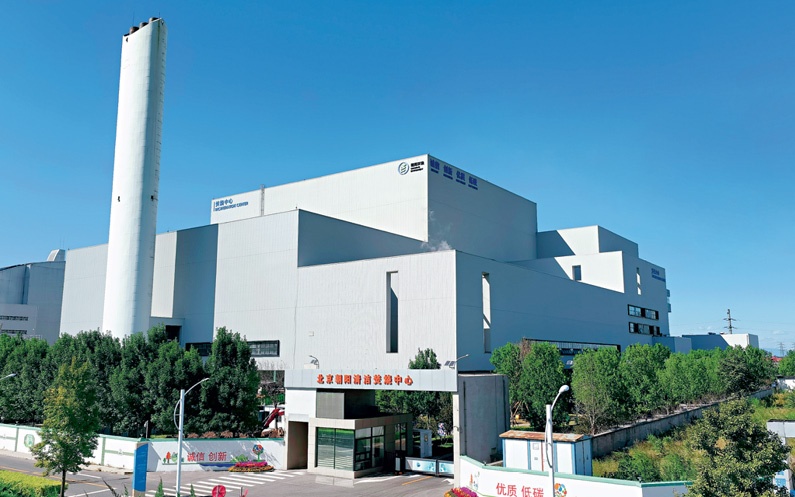
Water technology, urban management, low-carbon transformation, digital and intelligent development – these were the keywords in the Exhibition Hall of Environmental Services at Shougang Park, a former steel plant that has been transformed into a vibrant new cultural landmark of Beijing, during the 2025 China International Fair for Trade in Services (CIFTIS) held from September 10 to 14, 2025.
Under a theme of empowering the earth with green productivity, nearly 30 demonstration examples of Beijing’s environmental services were presented here. Over 80 enterprises showcased the cutting-edge achievements in three core fields: new energy and low-carbon services, ecological services and circular economy, and green digital technologies and services.
Facing the challenges in resource and environmental bearing capacity, Beijing has taken environmental services as a breakthrough to explore new paths for the green transformation of megacities like itself. Efforts have been made in areas including air pollution prevention, ecological restoration, green energy, and the construction of a zero-waste city. It has provided systematic and innovative models for the sustainable development of megacities across China and the globe.

An attendee (right) at the 2025 CIFTIS learns about the business of Chaoyang Environment Group.
Smart Water Management Systems
During CIFTIS, a water technology exhibition area attracted many visitors. Among the four sections, it displayed water affairs integrated technology in waterfront landscape cases, intelligent equipment, and data systems, which comprehensively showcased the city’s technological progress in water affairs during recent years.
“We’ve got rich examples exhibited this year. Highlights include new tourism landmarks such as Liangma River International Waterfront, Qinghe Island, and Wenyuhe Park,” said Wang Xiangcheng, director of the Technological and International Cooperation Department of the Beijing Water Authority. “Through these cases, people can see the diversified solutions for the integration of commerce, culture, and ecology, exploring the value of harmonious coexistence of people and water in the waterfront spaces. Besides, in terms of extreme climate response, there’s also a section showcasing an integrated monitoring system of sky, ground, water, and engineering.”
In recent years, Beijing has been exploring new technologies in water management. One example is the unmanned aquatic weed harvesters and water cleaning robots which have been put into use, reducing the risks of manual waterside operations. A dynamic monitoring network covering 425 rivers city-wide have also been established with quantum sensors, enabling the city staff to keep track of the water conditions in real time. The water data system has collected over 1.46 billion pieces of data and connected nearly 6,000 monitoring stations, providing strong support for flood control, drainage and water diversion.
At the Beijing Water Innovation Conference 2025 held on September 11, 2025, Hou Junshu, a member of the Party leadership group of the Standing Committee of Beijing Municipal People’s Congress, said that Beijing has become a trailblazer in smart water affairs management in recent years. As explained by him, from basic support to specific application scenarios, a number of projects such as smart dams, smart water plants, and digital twin systems have been implemented, upgrading the digital transformation of the city’s water management.
“In response to the governance demands of this megacity, technological progress has been made in areas including intensive utilization of water resources, prevention and control of water disasters, systematic governance of water environment, protection and restoration of water ecology, and water services for people’s livelihood,” Wang said.
“Based on the rich educational resources and an active market in Beijing, a synergy mechanism with government departments, enterprises, and research institutions working together has also materialized, guiding private capital to participate in the practice of technological integration,” Wang noted.

Front view of the group’s clean incineration center. Photos courtesy of Chaoyang Environment Group.
A New Waste Incineration System
Through a livestreaming screen at its booth, the Chaoyang Environment Group Co., released Beijing’s first full-chain smart incineration system on September 11, 2025. It has overcome challenging technical problems in the industry to build three core AI engines which can perceive, predict, and control the incineration.
Covering three square kilometers, the Chaoyang Environment Group, a national hi-tech enterprise, has extensive experience in collaborative treatment of urban waste. Its business involves the treatment of municipal solid waste, kitchen waste, hazardous waste, construction and renovation waste, and medical waste, the recovery and utilization of recyclable materials, and environmental protection facilities, as well as new technology development and promotion.
At this year’s CIFTIS, the group shared its experience in planning, technological research and development, project investment, operation, and the promotion of green development. For its circular economy industrial park, it has established a waste management system of leading international standard. It has also taken the lead in the collaborative treatment of large-scale urban waste of diverse sources and types. Its daily processing capacity exceeds 8,000 tonnes, and its comprehensive carbon emissions are close to zero. In addition, the group has promoted the synergy of pollution reduction and carbon emission reduction, engaging in the building of a zero-waste city.
At present, the annual supply capacity of crude oil in the park reaches 5,000 tonnes, the reuse rate of reclaimed water is 100 percent, and the resource conversion rate exceeds 85 percent. This results in annual green power generation exceeding 500 million kilowatt-hours, with an energy self-sufficiency rate of 100 percent.
In order to share the experience worldwide, the “Chaoyang Solution” for park-based collaborative processing of municipal solid waste proposed by the group was released at the ISWA World Congress 2024, organized by the Institute of Waste Management of Southern Africa (IWMSA). This was chosen as a seleccted practice case, providing a replicable Chinese model for urban solid waste management worldwide.
At the Global Green Economy Development Forum during the CIFTIS on September 12, together with 10 other organizations including the International Green Economy Association, the China Society for Sustainable Development, the China Quality Certification Center, and Beijing Enterprises City Services Group, the group initiated the China Ecological Partner Alliance for Sustainable Development Solutions, which aims to build an open, shared and innovative international cooperation platform to promote deep integration and global promotion of green technologies, services, and standards.
Pi Meng, chairman of the Chaoyang Environment Group, hoped that more partners can come on board to address global challenges such as climate change and resource shortages, in order to contribute Chinese wisdom and strength to achieving the 2030 Agenda for Sustainable Development adopted by all United Nations member states.
“The mission of our group is not only to handle waste, but also to create value from it and lead innovation,” explained Pi. He added that integrating green technology into urban development will promote the harmonious coexistence between humans and nature to a great extent.